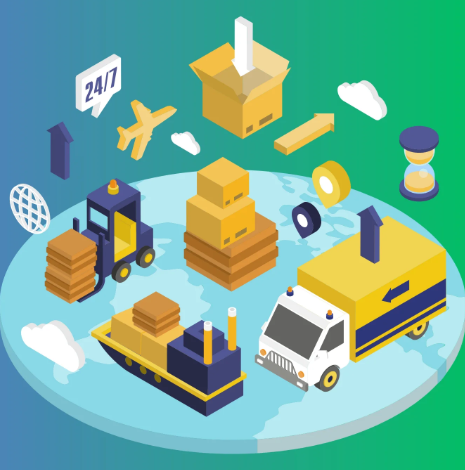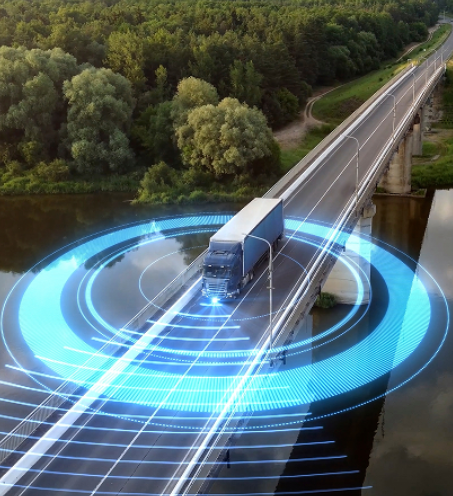Transforming Logistics Tracking with AI: A New Era of Real-Time Visibility

In the fast-moving world of logistics, effective tracking is crucial for ensuring smooth operations and customer satisfaction. However, traditional tracking methods often fall short, leaving gaps in visibility and efficiency. AI is now revolutionizing logistics tracking, providing real-time insights that enhance accuracy, transparency, and responsiveness.
In this blog, we’ll explore how AI is reshaping logistics tracking and what businesses can do to leverage these advancements for greater efficiency and customer satisfaction.
Challenges in Traditional Logistics Tracking
- Fragmented Visibility Across the Supply Chain
Global supply chains involve multiple transportation modes, facilities, and regions. Each stakeholder in the process often uses different tracking systems, leading to fragmented data and a lack of comprehensive visibility. This lack of end-to-end tracking results in delays, inefficiencies, and higher operational costs. - Data Silos and System Incompatibility
Many logistics companies rely on outdated systems that don’t work well together. This creates data silos, making it difficult to aggregate and analyze information across the supply chain. Compatibility between systems is essential for achieving smooth operations and accurate tracking across various stages of shipment. - Inaccurate Tracking Information
Manual data entry and basic tracking technologies like barcodes and RFID often lead to errors. These inaccuracies can cause confusion about the status of shipments, undermining trust in the logistics process. To improve reliability, AI systems can offer more accurate tracking through technologies such as GPS, real-time sensors, and machine learning. - Limited Access to Real-Time Data
Traditional systems often only provide updates at fixed intervals, which doesn’t allow for real-time decision-making. Without constant updates, logistics companies may miss critical issues like delays or disruptions. Real-time tracking, enabled by IoT sensors and cloud platforms, ensures that companies can respond promptly to any changes. - Lack of Predictive Capabilities
Traditional systems focus mainly on current conditions, which makes it hard to predict and prevent potential disruptions. AI-powered systems, on the other hand, can forecast delays or issues based on historical data and current trends, allowing logistics companies to take proactive steps before problems arise. - Navigating Complex Regulations
Logistics operations must comply with various regulatory requirements, such as customs and security protocols. Traditional systems struggle to manage compliance while also maintaining efficiency. AI can help automate and streamline compliance processes, ensuring that shipments meet legal requirements without delays.
How AI Solves Key Challenges in Logistics Tracking
- Data Integration and Analysis
AI excels at integrating data from various sources, such as GPS, RFID, and IoT sensors. By analyzing this data, AI provides a clear picture of shipment status, location, and condition across the entire supply chain. This integration enables end-to-end visibility, which helps logistics companies make proactive decisions and optimize their operations. - Predictive Analytics for Problem-Solving
AI-powered predictive analytics forecast potential issues by analyzing past and real-time data. This allows companies to anticipate delays, reroute shipments, or adjust schedules before problems escalate. Predictive insights help mitigate risks, improve on-time delivery rates, and boost customer satisfaction. - Real-Time Monitoring and Decision Support
AI systems enable continuous tracking of shipments and vehicles, offering instant updates on their status. Real-time data enables quick decision-making, such as adjusting routes or delivery schedules. This flexibility ensures logistics companies can adapt to changing conditions and keep operations on track. - Automated Exception Handling
When disruptions occur, AI can automatically detect and address issues, such as route deviations or discrepancies in tracking data. AI systems use predefined rules and machine learning algorithms to trigger workflows that resolve these exceptions, reducing the need for manual intervention and ensuring quicker problem resolution. - Continuous Learning and Optimization
AI doesn’t just solve problems; it learns from them. By analyzing performance data and feedback, AI algorithms continuously optimize logistics processes. This ongoing learning helps companies refine their operations, improve decision-making, and enhance overall efficiency over time.
AI Technologies Revolutionizing Logistics Tracking
- Digital Twins
Digital twins are virtual representations of physical assets in the supply chain. These digital models allow for real-time monitoring, predictive analytics, and scenario simulations. By using digital twins, companies gain better control over their operations and can optimize logistics strategies for improved efficiency. - Blockchain Technology
Blockchain provides a secure and transparent way to track shipments and share data across stakeholders. By ensuring that transaction records are immutable, blockchain enhances the traceability of goods and reduces the risk of fraud or errors. It also streamlines processes like customs clearance, providing tamper-proof records of shipments. - Automated Workflows
AI and robotic process automation (RPA) help streamline repetitive tasks like data entry and document processing. By automating these workflows, logistics companies can reduce errors, improve efficiency, and scale operations to handle fluctuating demand. Automation speeds up decision-making and ensures seamless integration between different systems.
The Benefits of AI in Logistics Tracking
- Enhanced Operational Efficiency
AI streamlines tracking processes, reducing manual effort and improving decision-making. This leads to faster delivery times, lower labor costs, and better resource utilization, resulting in significant cost savings and improved overall performance. - Greater Visibility and Transparency
AI-driven tracking systems provide complete visibility from start to finish, which builds trust with customers and partners. This transparency reduces disputes, minimizes lost shipments, and improves customer satisfaction, ultimately driving higher retention rates and increased revenue. - Proactive Issue Resolution
AI’s predictive capabilities allow logistics companies to identify potential issues before they arise. This proactive approach helps reduce delays, improve service reliability, and mitigate risks, leading to a better customer experience and reduced operational costs. - Optimized Resource Allocation
AI helps allocate resources more efficiently by analyzing real-time data. It can determine the best routes, schedules, and delivery priorities, maximizing the use of vehicles and labor while minimizing fuel consumption and wear and tear. - Informed Decision-Making
AI systems provide actionable insights that enable logistics managers to make better decisions. By analyzing tracking data, AI helps companies optimize inventory, plan routes, and allocate resources effectively, leading to improved performance and profitability.
Conclusion
AI is fundamentally transforming the way logistics companies track and manage shipments. With real-time data, predictive insights, and seamless integration, AI-driven tracking solutions are setting new standards for efficiency, accuracy, and customer satisfaction. As logistics operations continue to embrace these advancements, the future of supply chain visibility and tracking has never looked brighter. AI is not just the future of logistics; it’s the now.




